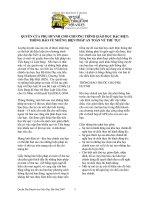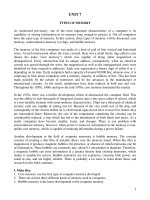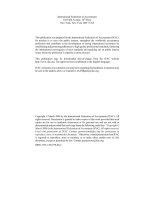Tài liệu Unit_7: Types of memory docx
Bạn đang xem bản rút gọn của tài liệu. Xem và tải ngay bản đầy đủ của tài liệu tại đây (37.04 KB, 3 trang )
1
Unit 7
Types of memory
As mentioned previously, one of the most important characteristics of a computer is its
capability of storing information in its memory long enough to process it. Not all computers
have the same type of memory. In this section, three types of memory will be discussed, core
memory, semiconductor memory (or chip), and bubble memory.
The memory of the first computers was made of a kind of grid of fine vertical and horizontal
wires. At each intersection where the wires crossed, there was a small ferrite ring called a core
(hence the name “core memory”) which was capable of being either magnetized or
demagnetized. Every intersection had its unique address, consequently, when an electrical
current was passed through the wires, the magnetized as well as the unmagnetized cores were
identified by their respective addresses. Each core represented a binary digit of either 0 or 1,
depending on its state. Early computers had a capacity of around 80.000 bits; whereas now, it is
surprising to hear about computers with a memory capacity of millions of bits. This has been
made possible by the advent of transistors and by the advances in the manufacture of
miniaturized circuitry. As the result, mainframes have been reduced in both size and cost.
Throughout the 1950s, 1960s and up to the mid-1970s, core memory dominated the market.
In the 1970s, there was a further development which revolutionized the computer field. This
was the ability to etch thousands of integrated circuits onto a tiny piece (chip) of silicon, which
is a non-metallic element with semiconductor characteristics. Chips have thousands of identical
circuits, each one capable of storing one bit. Because of the very small size of the chip, and
consequently of the circuits etched on it, electronical signs do not have to travel far; hence, they
are transmitted faster. Moreover, the size of the components containing the circuitry can be
considerably reduced, a step which has led to the introduction of both minis and micro. As a
result, computers have become smaller, faster, and cheaper. There is one problem with
semiconductor memory, however: when power is removed, information in the memory is lost-
unlike core memory, which is capable of retaining information during a power failure.
Another development in the field of computer memories is bubble memory. The concept
consists of creating a thin film of metallic alloys over the memory board. When this film is
magnetized, it produces magnetic bubbles, the presence, or absence of which represents one bit
of information. These bubbles are extremely tiny, about 0.1 micrometer in diameter. Therefore,
a magnetic bubble can store information at a greater density than existing memories, which
makes it suitable for micros. Bubble memories are not expensive, consume little power, are
small in size, and are highly reliable. There is probably a lot more to learn about them, and
research in this field continues.
I. Main idea
1. Core memory was the first type of computer memory developed
2. There are at least three different kinds of memory used in computers.
3. Bubble memory is the latest development in the computer memory.
2
II. Understanding the passage
Are the following statements true or false?
1. The most important function of a computer is to hold information in its memory in order to
process it.
2. Minicomputers, microcomputers, and mainframes all have the same kind of memory.
3. Semiconductor memory was developed before core memory and after bubble memory.
4. Core memory uses small metal rings which can be magnetized or unmagnetized.
5. The state of the core can be represented by either 0 or 1.
6. Early computer memories had less storage capacity than newer ones.
7. A transistor and a chip are the same kind of device.
8. The development of chips made it possible for minicomputers and microcomputers to be
invented.
9. Bubble memory is smaller than a chip.
10. Bubble memory does not have very many advantages.
III. Locating information
Find the place where the following ideas are expressed.
1. First there is core memory
2. Further to this development, chips evolved.
3. There are three types of memory.
4. This consists of producing a thin film over a memory board.
5. Then semiconductor memory was developed
6. There is still a lot to learn about this precess
7. This is made up of thin wires and rings.
8. Finally, bubble memory was invented.
IV. Contextual reference
What do the words in bold typeface refer to?
1. long enough to process it
2. where the wires crossed
3. which was capable of being
4. by their respective addresses
5. This has been made possible
6. which revolutionized the computer field
7. each one capable of storing one bit
8.
of the circuits etched on it
9. it produces magnetic bubbles
10. of which represents one bit.
V. Understanding words
Find synonyms for the following words
Find antonyms for the following words
1. said
2. own
3. progress
1. neither…nor
2. bypassed
3. increased
3
4. keeping
5. appropriate
4. not producing
5. don’t use up
VI. Choose the appropriate form of the words to complete the sentences
1. alteration, alter, altered
a. When a program doesn’t work properly, it is often necessary to make………. to it
b. The omission of data from a program can………. its results drastically.
c. The use of the computer in business has………. The workload of many people.
2. electricity, electric, electrical, electrically
a. A lot of………. is needed to operate large computer systems.
b. Alexander Graham Bell invented the……….light bulb.
c. Many students today are studying to become………. engineers.
3. reduction, reduce, reduced
a. The introduction of the computer in the workplace has………. the workload of many
people
b. There will probably be a great……….in the consumption of oil in the next decade due to
the use of computer technology.
4. creation, create, created, creative
a. A programmer usually has a………. as well as a logical mind.
b. It takes a lot of inspiration and hard work to come up with a new……….in computer
technology.
c. Computers have certainly………. new opportunities for fraud.
VII. Complete the following sentences by referring back to the text
1. In the 1970s, there was a………. development which revolutionized the computer field.
2. ………., the size of the components containing the circuitry can be considerably reduced
3. ……….development in the filed of computer memories is bubble memory.
VIII. Content review
Use the information in the text to complete the table
Type Developed Size Composition Memory
capacity
1. Large
80.000 bits
2. Integrated
circuits on non-
metallic element
3.









